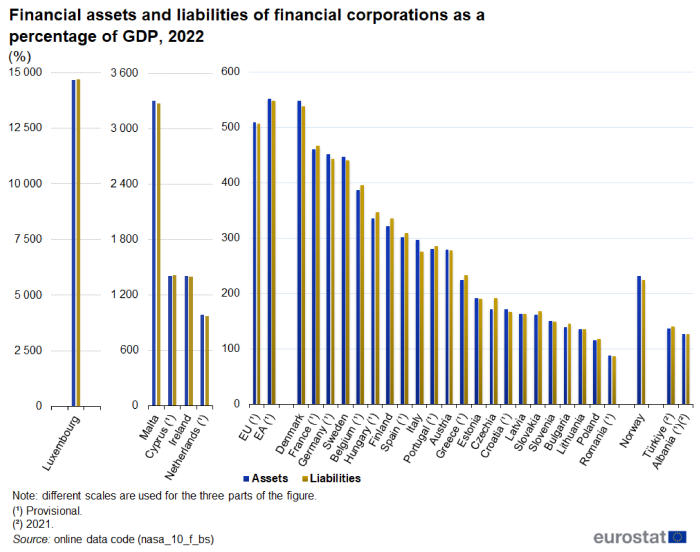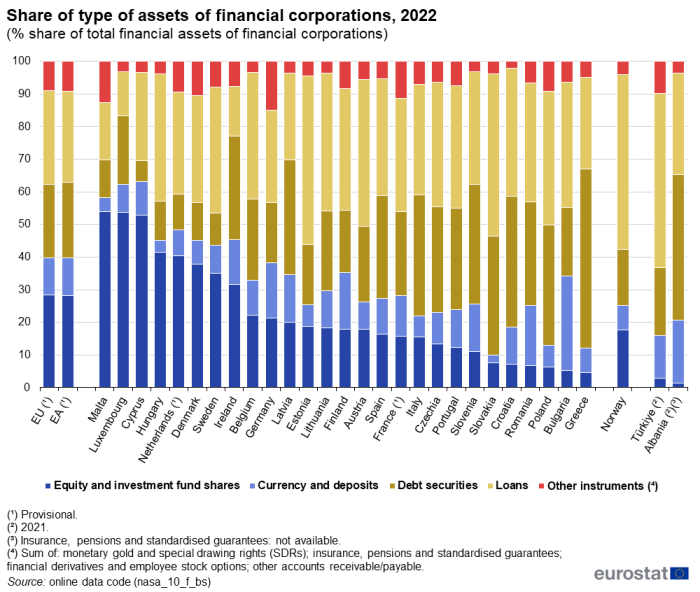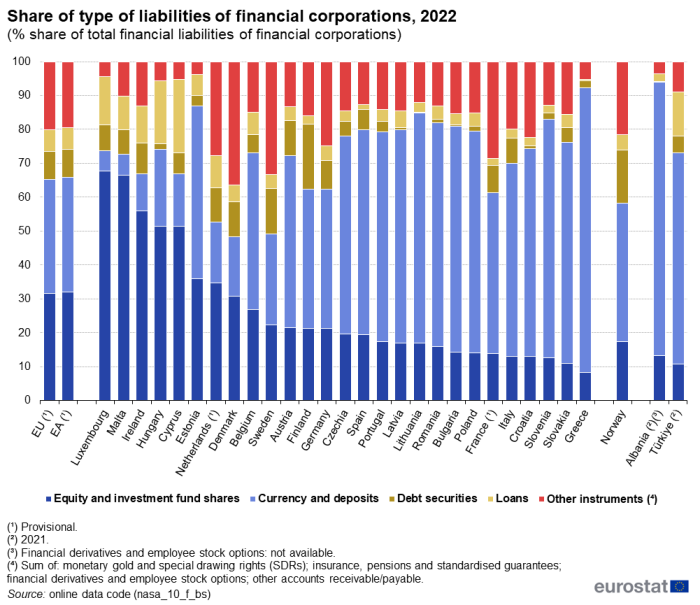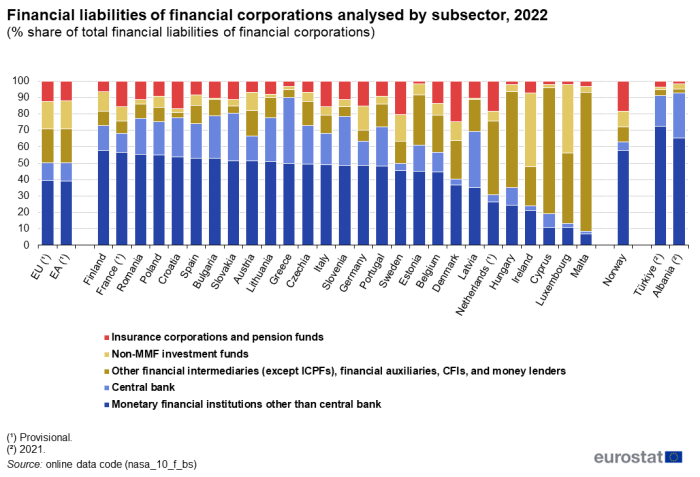Financial corporations - statistics on financial assets and liabilities
Data extracted on 26 October 2023.
Planned article update: November 2024.
Highlights
In 2022, five EU Member States (Germany, France, Luxembourg, the Netherlands and Ireland) collectively accounted for around 71 % of the financial assets and liabilities of financial corporations in the EU.
The total financial assets and liabilities of financial corporations in the EU grew almost continuously between 1995 and 2021 but decreased in 2022.

(%, change over previous year)
Source: Eurostat (nasa_10_f_bs)
This article focuses on the annual stock of financial assets and liabilities for financial corporations. Note that there are complementary articles that provide similar information on households and non-financial corporations. A comparison between these sectors (excluding general government) is available in the article on non-financial corporations.
The financial corporations sector consists of institutional units which are independent legal entities and market producers, and whose principal activity is the production of financial services. Such institutional units comprise all corporations and quasi-corporations, which are principally engaged in:
- financial intermediation (financial intermediaries); and/or
- auxiliary financial activities (financial auxiliaries).
Also included are institutional units providing financial services where most of either their assets or their liabilities are not transacted on open markets.
Across the European Union (EU), the financial assets of financial corporations mainly comprise loans, equity and investment fund shares, and debt securities. The financial liabilities of financial corporations mainly comprise equity and investment fund shares, currency and deposits, and insurance reserves, pension entitlements and standardised guarantees.
The data presented in this article relate to a detailed set of consolidated financial balance sheets for the financial corporations sector, as released by Eurostat. Note that statistics detailing the financial accounts may be consolidated or non-consolidated; the latter record not only transactions and positions between sectors (in other words, financial corporations with other actors in the economy) but also transactions and positions within the same sector (in other words, between financial corporations).
This article provides an analysis of financial assets and liabilities in the EU and the euro area (EA), as well as for individual EU Member States, one of the EFTA countries (Norway) and two of the enlargement countries (Albania and Türkiye) for the latest year available (2022). Some indicators are presented in relation to gross domestic product (GDP), which is beneficial for making cross-country comparisons, especially between countries of different size.
Full article
Assets and liabilities
Financial assets of EU financial corporations valued in 2022 at 5.6 times GDP
Total financial assets of financial corporations in the EU were valued at €81 091 billion in 2022; this was slightly higher than the value of their financial liabilities, which stood at €80 574 billion, a difference of €517 billion (or 0.6 %). This difference was somewhat smaller than that in 2021, when it was €890 billion (or 1.1 %).
The annual rate of change for total financial assets and liabilities of financial corporations between 2021 and 2022 is illustrated in Figure 1. The EU recorded decreases of 1.7 % and 1.3 % for assets and liabilities, respectively.
It should be noted that rates of change are calculated in national currencies. Among the EU Member States, the highest annual growth rates were observed in Bulgaria, up 10.6 % for assets and 11.7 % for liabilities. The next fastest growth rates were recorded for Estonia (8.1 %) and Hungary (7.8 %) for assets; for Romania (7.9 %), Estonia and Hungary (both 7.7 %) for liabilities. A total of 11 Member States had negative annual rates of change for assets, with the fastest decreases in Slovakia (down 13.1 %) and Luxembourg (down 8.9 %). For liabilities, seven Member States recorded a decrease, the largest also being in Slovakia (down 10.2 %) and Luxembourg (down 8.9 %).

(%, change over previous year)
Source: Eurostat (nasa_10_f_bs)
The share of each EU Member State in the EU's total financial assets and liabilities of financial corporations in 2022 is presented in Figure 2. Germany held just over one fifth of the financial assets (21.6 %) and liabilities (21.3 %) of financial corporations in the EU, followed by France (15.0 % for assets and 15.3 % for liabilities), Luxembourg (14.0 % for assets and 14.1 % for liabilities), the Netherlands (11.7 % for assets and 11.5 % for liabilities) and Ireland (both 8.8 %). These five Member States collectively accounted for 71.0 % of the financial assets and 71.1 % of the financial liabilities of financial corporations in the EU. Apart from Italy and Spain, the other Member States held shares of 3.0 % or less.
Some of the smaller EU Member States accounted for relatively high shares of the financial assets and liabilities of financial corporations in the EU in 2022. This was clearly the case for Luxembourg, which had the third highest shares (after Germany and France), as well as for Ireland, which had the fifth highest shares. This reflects the large international activity of the financial sector in both of these Member States.
A comparison between the shares of financial assets and financial liabilities for each EU Member State reveals that these were generally similar. Italy had the largest difference, as Italian financial corporations held a 0.5 percentage points (pp) higher share of the EU's financial assets than their share of the EU's financial liabilities.

(%)
Source: Eurostat (nasa_10_f_bs)
Figure 3 presents the financial assets and liabilities of financial corporations as a percentage of GDP. In 2022, these assets were valued in the EU at 510 % of GDP, while these liabilities were valued at 507 %, resulting in net financial assets equivalent to 3.2 % of GDP.
The financial assets and liabilities of financial corporations in Luxembourg were valued in 2022 at around 14 700 % of GDP, in other words 147 times the level of GDP. Luxembourg's financial assets and liabilities as a percentage of GDP were 29 times the EU average. In Malta, financial assets and liabilities of financial corporations were valued around 33 times the level of GDP, while in Cyprus, Ireland and the Netherlands the values were 10–14 times the level of GDP. Apart from Denmark (where these assets and liabilities were valued, respectively, at 5.5 and 5.4 times GDP), this ratio was below 5.0 in all other EU Member States. Romania was the only Member State where the value of the financial assets and liabilities of financial corporations in 2022 was below that of GDP.
The data shown in Figure 3 demonstrate the importance of financial corporations in several small and medium-sized EU Member States: Luxembourg clearly stands out, while Malta, Cyprus and Ireland also have a high importance of financial corporations in relation to their GDP.

(%)
Source: Eurostat (nasa_10_f_bs)
Structure of assets and liabilities
The largest shares of financial corporations' financial assets were equity and investment fund shares, loans and debt securities
Financial corporations' financial liabilities were mainly currency and deposits, and equity and investment fund shares
There are four prominent types of instruments of assets and liabilities of financial corporations in the EU: currency and deposits; debt securities; loans; equity and investment fund shares. Four other types of assets and liabilities accounted for smaller shares (from 0.2 % to 5.1 % each) of total financial assets of EU financial corporations in 2022: monetary gold and special drawing rights (SDRs); insurance, pensions and standardised guarantees; financial derivatives and employee stock options; other accounts receivable/payable. In this article, these smaller types of instruments are grouped together as other instruments – see Figure 4 for assets and Figure 5 for liabilities.
The category of loans accounted for the largest share (28.6 %) of financial assets of EU financial corporations in 2022. This type of instrument was followed by equity and investment fund shares (28.3 %) and debt securities (22.6 %). Currency and deposits and other instruments accounted for 11.4 % and 9.0 %, respectively.
A majority of the EU Member States had debt securities, loans, and equity and investment fund shares as the three largest types of assets held by financial corporations in 2022.
- Six Member States had equity and investment fund shares as their principal instrument: Malta (54.0 % of assets), Luxembourg (53.7 %), Cyprus (53.0 %), Hungary (41.5 %), the Netherlands (40.5 %) and Denmark (37.8 %).
- The largest share of assets in Greece, Croatia, Italy, Slovenia, Latvia and Ireland was in debt securities; this was also the case in Albania (2021 data).
- In all other Member States, the principal instrument was loans, as was also the case in Norway and Türkiye (2021 data).
Aside from these three main instruments, the share of assets in currency and deposits was relatively large (over 15.0 %) in Germany, Finland, Romani and Bulgaria. More than 10.0 % of assets were in other instruments in Denmark, France, Malta and Germany, mainly financial derivatives and employee stock options and/or other accounts receivable/payable.

(% share of total financial assets of financial corporations)
Source: Eurostat (nasa_10_f_bs)
The largest shares of total financial liabilities of the EU's financial corporations in 2022 were currency and deposits (33.7 %) and equity and investment fund shares (31.5 %). Among other instruments (20.0 %), a substantial share of liabilities was due to the contribution of insurance, pensions and standardised guarantees (which had a 11.9 % share of the total value of liabilities).
A comparison of the structure of financial assets and liabilities for the EU's financial corporations in 2022 shows that loans and debt securities made up larger shares (28.6 % and 22.6 % respectively) of assets compared with much smaller shares (6.5 % and 8.2 %) of liabilities. By contrast, currency and deposits accounted for 11.4 % of assets compared with 33.7 % of liabilities. Insurance, pensions and standardised guarantees also made up a relatively high share of liabilities (11.9 %) compared with a small share of assets (0.2 %).
Among the EU Member States, the largest types of instruments held by the EU's financial corporations in 2022 were generally currency and deposits, equity and investment fund shares, and other instruments.
- Currency and deposits represented 84.0 % of liabilities in Greece, 70.4 % in Slovenia, and 67.9 % in Lithuania. Currency and deposits also accounted for more than half of the total in a further 12 Member States as well as in Albania and Türkiye (both 2021 data). In a further four Member States, currency and deposits accounted for the largest share of liabilities, although this share was below 50.0 %; this was also the case in Norway.
- More than half of the total liabilities were equity and investment fund shares in Luxembourg (67.7 %), Malta (66.4 %), Ireland (56.1 %), Hungary (51.4 %) and Cyprus (51.3 %). In the Netherlands, currency and deposits also accounted for the largest share of liabilities, although this share was below 50.0 %.
- Denmark and Sweden were the only Member States where the largest share of liabilities was held as other instruments, in both cases mainly insurance, pensions and standardised guarantees.
Among the smaller instruments, loans were relatively important in 2022 in Cyprus (21.5 % of the total) and Hungary (18.7 %), while debt securities accounted for 19.2 % of liabilities in Finland.

(% share of total financial liabilities of financial corporations)
Source: Eurostat (nasa_10_f_bs)
Developments
The value of financial assets of financial corporations as a percentage of GDP increased in 2022 in most EU Member States
Growth in the total financial assets of EU financial corporations was almost uninterrupted during the period 2012–2021; the only decrease was in 2013 (down 0.4 %). By 2021, the total value had increased by 51.2 %, from €54 557 billion in 2012 to €82 495 billion in 2021. A similar development was observed for total financial liabilities over the same period. These increased 53.0 % from €53 339 billion in 2012 to €81 606 billion in 2021. This upward development for financial assets and financial liabilities was reversed in 2022. The value of assets fell 1.7 % to €81 091 billion in 2022 and the value of liabilities fell 1.3 % to €80 574 billion, equivalent to 48.6 % and 51.1 %, respectively, above their 2012 values.
The value of financial assets of financial corporations as a percentage of GDP was 53.7 pp lower in 2022 than in 2021 in the EU, a relative decrease of 9.5 %. This ratio decreased in 2022 in every EU Member State (see Figure 6). The largest relative decrease observed among the EU Member States was for Slovakia (down 20.5 %), although a larger decrease was observed in Norway (down 21.4 %). The smallest decrease among the Member States was 3.2 %, observed in Germany.

(%)
Source: Eurostat (nasa_10_f_bs)
The contributions of each subsector of financial corporations were similar for assets and for liabilities
The contributions in 2022 from each subsector of financial corporations across the EU were similar for assets and for liabilities. The specialisation within certain subsectors is illustrated in Figures 7 and 8.
The largest subsector within financial corporations in the EU was monetary financial institutions other than the central bank, with a 40.1 % share for assets and 39.6 % share for liabilities. This was followed by other financial intermediaries (except insurance corporations and pension funds (ICPFs)), financial auxiliaries, captive financial institutions (CFIs) and money lenders, with 20.7 % of assets and 20.6 % of liabilities. The third largest shares were for non-money market fund (non-MMFs) investment funds (15.9 % of assets and 16.5% of liabilities), insurance corporations and pension funds (12.8 % of assets and 12.5 % of liabilities) and the central bank (10.5 % of assets and 10.8 % of liabilities).
For 21 EU Member States (as well as Norway, Albania (2021 data) and Türkiye (2021 data)), monetary financial institutions other than the central bank held the largest shares of assets and liabilities.
- In Cyprus, Luxembourg, Hungary, Malta and the Netherlands, the highest shares of assets and liabilities were in other financial intermediaries (except ICPFs), financial auxiliaries, CFIs and money lenders.
- In Ireland, the highest shares of assets and liabilities were in non-MMF investment funds.
For monetary financial institutions other than the central bank, the highest shares of assets were recorded in Finland, France, Poland and Romania, all around 56–59 %. For the central bank, shares of 40.1 % and 33.9 % were recorded in Greece and Latvia, respectively. For other financial intermediaries (except ICPFs), financial auxiliaries, CFIs and money lenders, shares in excess of 50 % were observed in Malta, Cyprus and Hungary. For non-MMF investment funds, Ireland and Luxembourg reported shares that were more than double those in any other EU Member State, 45.3 % and 41.9 %, respectively. The highest shares for insurance corporations and pension funds were in Sweden and Denmark, 24.6 % and 24.1 %, respectively.
Looking at the combined contributions of the central bank and other monetary financial institutions, the shares were low in several EU Member States that have a large financial corporations sector, namely Malta, Luxembourg, Cyprus, Ireland and the Netherlands.

(% share of total financial assets of financial corporations)
Source: Eurostat (nasa_10_f_bs)

(% share of total financial liabilities of financial corporations)
Source: Eurostat (nasa_10_f_bs)
Source data for tables and graphs
Data sources
The compilation of financial accounts follows the European System of Accounts 2010 (ESA 2010).
The financial account and balance sheet
Eurostat's website includes detailed financial accounts by country. Financial accounts are published in consolidated and non-consolidated forms; within this article the former are presented. As a rule, the accounting entries in ESA 2010 are non-consolidated, as a consolidated financial account requires information on the counterpart grouping of institutional units. Note that data for the EU and EA aggregates are calculated as a sum of data for EU and EA Member States; no adjustment is made for flows between Member States and EU institutions.
Context
Financial accounts form part of the national accounting framework and are compiled in the EU in accordance with ESA 2010. They are a significant tool for analysing financial developments and policy decisions, and provide key statistical information on financial transactions, other financial flows, and financial balance sheets by institutional sector, including financial corporations. Particular issues relating to the financial corporations sector include its capacity to withstand shocks. Indeed, since the global financial and economic crisis financial accounts for financial corporations have been integrated into an enlarged set of policy indicators – the EU's macroeconomic imbalance procedure (MIP) surveillance mechanism – that are used to identify potential macroeconomic risks early on, prevent the emergence of harmful macroeconomic imbalances and correct the imbalances that are already in place. For the financial sector, the MIP indicator concerns the total financial sector liabilities, although it excludes monetary gold and special drawing rights.
The types of assets and liabilities that financial corporations hold carry different levels of risk and can be used to assess financial risk.
Direct access to
- Financial flows and stocks (nasa_10_f)
- Financial balance sheets - annual data (nasa_10_f_bs)